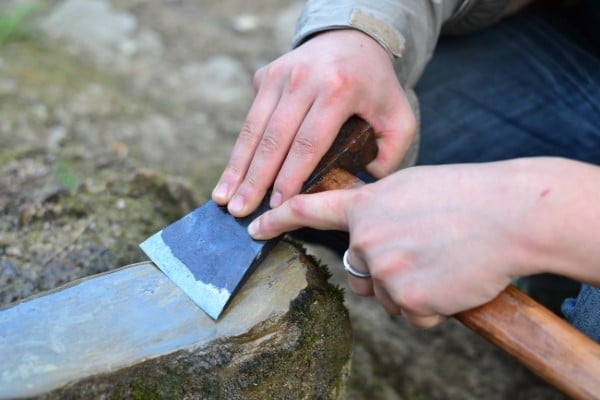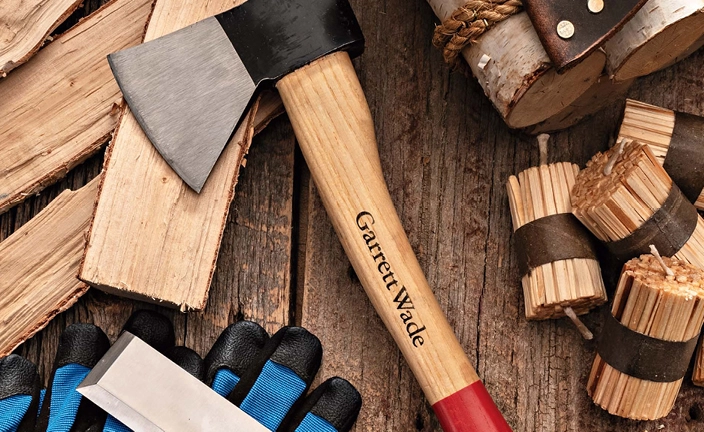Do you want to get the most out of your axe? Are you tired of trying out different sharpening techniques, without any success?
In this article, you’ll learn how to sharpen your axe for optimal cutting performance. From technique selection and tooling choices, to the finer details of sharpening your axe, you’ll have everything you need to make even the toughest cutting jobs a breeze.
Having a sharp axe is essential for cutting tasks. Whether you are felling trees, splitting logs, or limbing branches, having the right tool for the job is essential. A dull axe won’t get the job done quickly and will make the task more laborious. A sharp axe gets the work done efficiently and effectively with less effort and time required. Thus, it is important to sharpen your axe regularly in order to maintain its optimal performance.
This guide will provide you with step-by-step instructions on how to sharpen an axe, including what tools you need, method of sharpening, and safety tips to keep in mind while sharpening. With this guide, you can ensure your axe always stays in perfect condition and ready to tackle any chore or task!

Importance of sharpening an axe
Having a sharp axe is essential for safe and effective cutting. It is important to sharpen your axe regularly in order to protect yourself, help with work efficiency, and ensure the highest quality of cutting performance.
A dull blade requires more effort when cutting and can produce dangerous kickbacks due to the constant pressure required for it to cut. With a sharpened axe, the blades are able to easily cut through logs with ease, therefore decreasing your risk of injury from kickbacks.
Additionally, regular sharpening of an axe ensures that you are able to work quickly as task completion becomes easier and faster due to its sharpness. This also helps with providing smooth cuts every time as it is able to slide through the log or tree easily without missing spots or chunks from a dull blade.
Overall, having a well-sharpened axe is crucial in ensuring safety while providing optimal performance in wood working projects.
Benefits of a well-sharpened axe
A sharp axe is essential for optimal cutting performance. A well-sharpened axe can make precise cuts, be easier to use and control, create less waste, and even improve safety by reducing the chance of the blade slipping off of particularly stubborn pieces of wood. When it comes to sharpening your axe, there are a few key benefits that you should consider.
First, a well-sharpened axe will require significantly less effort to make cuts. Dull blades require more digging, pushing and hammering as opposed to slicing through the material with ease. This means less fatigue for you when performing heavier tasks over an extended period of time and more consistent results.
Second, sharper blades create much cleaner cuts that help preserve the integrity of the wood you’re cutting – leaving no chance of splintering or cracking while preserving its natural good looks. Tight joints in woodworking projects are all but impossible without a finely sharpened tool at your side.
Finally, while it may seem counterintuitive, a properly sharpened blade is actually much safer than one that is dull or damaged due to wear and tear over extended use. As previously mentioned, sharper blades can reduce the amount of force needed when making precision cuts which in turn increases accuracy and reduces the risk of potential injury from misfires or off-angle slices into knots and other types of tough materials found in trees or logs.
Step-by-Step Guide for Sharpening an Axe
Sharpening an axe is an essential part of proper maintenance and can greatly improve its performance when in use. Following correct technique will help you to achieve optimal edge sharpness while avoiding common pitfalls that can occur when sharpening any type of edged tool. To get the best results, we have broken down the process into a few simple steps which we will discuss in further detail:
- Secure the Axe: Securely affix your axe to a flat and stable surface such as a protective work bench or sturdy table to avoid any potential accidents or injury. Before you begin sharpening, make sure to double-check that the axe is firmly secured so as not to move around during the process.
- Set Bevel Angle: The bevel angle for an axe typically ranges from 25-35 ° depending on its intended purpose, with most general use axes requiring a slightly lower angle than what would be used for splitting wood axles; typically 29-32° is recommended for most purposes. Adjust the surface of your sharpening stone accordingly so that it matches the desired angle before starting your strokes to ensure parallel lines across the whole blade face.
- Sharpen Edge: Start by applying pressure along both sides at once in firm, even strokes across the grinding face until all nicks or grooves have been filled in with steel filings – usually roughly two minutes per side is enough before switching over and giving equal attention to other side until it has been sharpened evenly across both edges of blade.
- Test Sharpness: Once complete, take a few moments to confirm your results by slicing through several thin sheets of paper – if it’s cutting through them cleanly without tearing, folding or snagging on edges then that’s an indication of good sharpness! Alternatively, if not yet satisfied with reduction in nicks or grooves then repeat steps 3 & 4 as necessary until desired razor edge has been achieved.
- Polish Edge & Apply Oil/Protective Coatings: Once happy with blade’s keenness use either diamond grit dust/compound stone paste applied directly onto stone surface/cloth beforehand – rub these over & around edges followed by applying lubricant oil (vegetable/mineral) afterwards – which ideally should also coincide with shield finish being applied likewise too.
Preparing the axe
One of the first steps to sharpening an axe is proper preparation. Before you begin honing the blade, your axe should be properly cleaned. Start by removing any dirt, debris, or loose rust from the axe head and handle. Use a wire brush to remove any tough debris from the grooves of the handle and then wipe it down with a damp cloth.
Next, use a steel wool pad to carefully scrub the surface of the axe until it shines with no residue on it. Finally, rinse off the blade before your start sharpening. Doing this will ensure that you are getting optimum sharpening performance for your efforts.
Initial sharpening
The initial sharpening of a dull axe is the most important step and sets the foundation for future sharpening. To do this, use a two-stage process. First, use a coarse grade stone to sharpen the blade edge from the heel to the tip. This will go quicker with a power grinder, but can be done by hand with an appropriate axe sharpening stone with finer grit on one side and coarser grit on the other (in case you do want to do it by hand, start with coarse grit and then move on to finer grit).
After using the coarse grade stone, switch over to using a medium (600-800) or fine (1000 or higher) grade stone. Again proceed from heel to tip doing multiple passes over each area until an edge is established. This can be followed up with honing of the blade edge, which should result in a razor-sharp edge ready for use.
Fine sharpening
Fine sharpening requires an even sharper edge on your axe head than other sharpening methods. It is best used for detailed work and chopping softer woods, such as pine and fir. You must ensure that you are using the same angle when sharpening with a file or whetstone in order to retain optimal cutting performance.
The most effective way to do this is to sharpen your axe against a flat, diamond hone stone. This abrasive material will quickly bring back the sharpness of your cutting edge without thinning it out too much over successive sharpenings. However, if a diamond stone is not an option for you, a flat whetstone can also be used. If you intend to use a whetstone instead of a diamond hone stone, opt for a fine grit whetstone; generally between 800 and 1000 grit range should do fine depending on the type of axe you own (Japanese or American). Most whetstones have etching markers on them that will tell you what grade they are (i.e., course or medium-fine).
Once the blade has been ground with one side at an angle of 25 degrees, flip it over and use the opposite side of the stone flatten out any burrs that may have formed while coarse grinding earlier by running it along at zero degrees in respect with the blade’s edge.

Honing the edge
Honing the edge of an axe is the finishing step for sharpening it. Honing will maintain a sharper, long-lasting edge by periodically smoothing out any micro-serrations on the blade caused by use and sharpening. Honing can be performed with a variety of sharpening stones, depending on how deep the serrations are, with coarse stones being used for deeper serrations and finer stones to buff out minor micro-serrations.
Start by lightly applying oil or water to the stone, then simply draw the axe across it repeatedly in a sweeping motion while gradually increasing the pressure being applied. Be sure to maintain a consistent angle – generally around 20 degrees – and keep both sides even as you work across it. You’ll know you’ve finished honing when you get a mirror-like shine off of the blade near its edge. Once complete, use tearing paper or fabric to check for sharpness before use. Carefully examine your work before putting down your honing stone and clean up any excess oil or water on an old rag before finishing up. Done correctly, regularly using this technique should keep your axe in good shape for years to come!
Testing the sharpness
Once your axe blade is sharpened, it is important to test the sharpness of the edge. To do this, you can perform a basic “tug test”. Run your thumb along the edge of the axe over the middle section. If the edge catches on your thumb then it has been sharpened properly. It is important to note that this test should be performed with light pressure as too much force may damage the fragile axe head.
You can also use a whetstone or other sharpening tool to check for an even beveling and guarantee that no part of the blade has been missed in sharpening. In addition, inspecting for any distortion on either side gives you further assurance as to whether you have successfully created a symmetrical and balanced cutting surface on both sides.
Maintaining Your Sharpened Axe
Now that you know the best way to sharpen your axe for optimal cutting performance, it is important to maintain the edge and ensure that it stays in peak condition. Properly maintained and sharpened axes can last you a lifetime. Here are some tips on how to maintain your axe and ensure that it stays sharp for years to come:
-Clean your axe regularly with warm soapy water. This will remove any dirt or foliage which has built up around the cutting edge of the blade, and also make it more eye catching.
-Before using, inspect your axe head carefully for signs of wear or damage such as chips or dents. If any of these signs are present, take steps to address them right away as they can lead to further damage down the line.
-Oil the blade after use with a light weight oil or wax like WD-40; this will keep moisture away from the exposed metal parts and help prevent rusting.
-When storing your axe, place it in an area where it won’t be subjected to extreme temperatures or excessive moisture so it will stay sharp longer.
Proper storage
When it comes to ensuring the optimal cutting performance of your axe, proper storage is key. Before storing your axe, make sure that the blade is clean and dry. Wipe down with a cloth to remove any mud or other debris and then dry thoroughly. Once it’s completely cleaned and dried, you should apply a thin layer of oil or wax on the blade to protect it from moisture and rust.
Store your axe in a dry location away from extreme temperatures. Placing it in a padded case or box is ideal for protecting the head from any bumps during storage. Make sure that there is no excess pressure being put on the handle when storing, as this can slowly damage the handle over time. Finally, make sure you keep all tools out of reach of children and animals where accidents may occur!
Regular maintenance
Proper maintenance of your axe is essential for optimal cutting performance. By taking the time to properly care for and maintain your axe, you can make sure that it will remain sharp and effective for many years.
To keep your blade in good condition, regular inspections and sharpening should be done on a regular basis. In order to maintain an optimum cutting performance, you should inspect your axe once every month or two for small nicks and chips. If small nicks or chips are discovered, the axe can then be sharpened using a whetstone or file. It is also important to regularly oil the blade of your axe so as to prevent rust from forming on the metal surface.
Finally, some higher quality brands may require more frequent sharpening than standard varieties as they tend to hold their edge longer and better. Always use caution when it comes to sharp edges and be sure to follow any specific maintenance instructions provided with the particular brand of axe that you own.
Importance of proper use
Using an axe that is properly sharpened can make all the difference in terms of cutting performance. Not only is it more efficient, but it can also help reduce the amount of time and effort required for even the simplest of tasks.
It’s important to be aware of how and when to use an axe correctly. The following are some tips for proper axe use:
- Make sure the blade is sharp before each use by using a round file or stone
- Use a wooden block or log as an anvil to sharpen your axe against
- Apply even pressure on both sides as you sharpen so that you create an evenly sharpened edge
- Move the file or stone along the length of the blade with eight to ten strokes
- Finish your honing off with a steel split wedge, which will give you a smoother end result
- Test the blade’s edge with your thumb to determine how sharp it has become
- Properly oil and maintain your axe after each use so that its life span will be extended
Conclusion
Sharpening your axe is an essential part of maintaining it and achieving optimal cutting performance. It doesn’t matter whether you are a professional or an avid DIYer, if you want your axe to perform at its best all the time, you need to sharpen it regularly and correctly.
The best way to sharpen an axe involves using a sharpening stone and the appropriate honing angle for your particular model. To prevent cutting yourself, protective gloves are always recommended. Always consult the manufacturer’s instructions for how to use their product as different types of sharpeners may require different techniques.
Finally, remember not to oversharpen your axe as it can cause damage to the blade. By following all these steps correctly, you will have an axe that will last longer and work better when needed.
FAQs
What is the best way to sharpen an axe?
The best way to sharpen an axe is to use a sharpening stone or file to remove any nicks or dullness and then hone the edge to a razor-sharp finish.
What is the optimal axe sharpening angle?
The optimal angle for sharpening an axe is between 25 and 30 degrees, depending on the type of axe and the intended use.
How do you sharpen an axe with work sharp?
To sharpen an axe with a Work Sharp electric sharpener, attach the appropriate abrasive belt, set the angle guide, and run the blade through the machine several times.
What is the correct way to sharpen a knife?
The correct way to sharpen a knife is to use a sharpening stone or rod to grind away any dullness and then hone the edge to a razor-sharp finish.
Should I sharpen at 15 or 20 degrees?
The optimal angle for sharpening a knife depends on the type of knife and the intended use, but a general rule of thumb is to sharpen at 20 degrees for durability or 15 degrees for sharpness.
What is 20 angle for sharpening?
A 20-degree angle is a common sharpening angle for knives and provides a balance between sharpness and durability.
What blade angle is the sharpest?
The blade angle that is sharpest is around 10 degrees, but this angle is not practical for most knives as it sacrifices durability.
Should an axe be razor sharp?
An axe does not necessarily need to be razor sharp, but it should be sharp enough to easily cut through wood without undue force or pressure.
How do you clean and sharpen an axe head?
To clean and sharpen an axe head, remove any rust or debris with a wire brush or sandpaper, use a sharpening stone or file to grind the edge to the desired sharpness, and then hone the edge to a razor-sharp finish.
Which knife sharpener is best?
The best knife sharpener depends on personal preference and budget, but some popular options include sharpening stones, electric sharpeners, and manual sharpeners such as honing rods or pull-through sharpeners.
See more-
- Best throwing axe 2023
- Best tactical axe 2023
- Best axe for cutting down trees 2023
- Best axe for chopping wood 2023
- Best axe 2023



